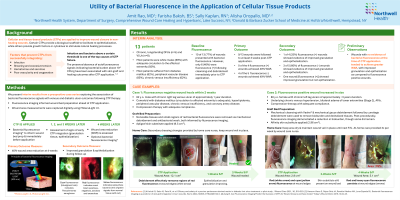Clinical Research
(CR-061) The Association of Bacterial Fluorescence Signals with Healing Outcomes Following Skin Substitute/ctp Therapy
Friday, May 2, 2025
7:45 PM - 8:45 PM East Coast USA Time

Amit Rao, MD – Northwell Health; Farisha Baksh, BS – Northwell Health; Sally Kaplan, RN – Northwell Health
Introduction: Cellular and tissue-based products (CTPs) are applied to improve wound closure in non-healing wounds. The presence of bacteria above a certain threshold (104 CFU/g) can reduce CTP efficacy, independent of overt infection, wasting time and resource1. This observational study explores the association of fluorescence signals indicating high bacterial loads with venous and diabetic ulcer outcomes following CTP therapy.
Methods: In this observational study, wound outpatients who were deemed ready for a CTP placement based on clinical judgement were enrolled and followed from their initial application to follow-up visits after 2 and 4 weeks. Prior to CTP application, an independent researcher determined bacterial presence/absence in and around the wound bed using a non-contact, bedside fluorescence imaging device*. The clinical team involved in the CTP procedure were blinded to the imaging results and were therefore unable to take any targeted actions to remove fluorescence that may have been present. Early CTP integration was assessed by the clinical team after 2-weeks (granulation tissue, epithelialization), and wound area reduction was assessed at 4-weeks, along with re-imaging to determine any changes in the wounds’ bacterial status.
Results: Among the five patients included in this interim analysis, bacterial fluorescence was often present in the wound bed, particularly along the wound edges in venous and diabetic ulcers, even after routine wound bed preparation. Fluorescence noted at CTP application tended to persist at follow-up visits. Wounds tended to fare better when fluorescence signals were absent, with evidence of granulation and epithelization after 2 weeks and a reduction in wound area after 4 weeks. Conversely, the presence of fluorescence seemed to correlate with poor CTP outcomes. Granulation and epithelization were less common in fluorescence positive wounds, and wounds either increased in size or showed poor percent area reduction after 4 weeks.
Discussion: The presence of moderate-heavy bacterial colonization, determined by bacterial fluorescence imaging, correlated with poor 4-week healing outcomes following CTP application as compared to fluorescence-negative wounds. These findings suggest that bacterial fluorescence imaging could improve CTP outcomes by enhancing wound bed preparation protocols and facilitating targeted removal of bacterial loads that reduce CTP efficacy.
Methods: In this observational study, wound outpatients who were deemed ready for a CTP placement based on clinical judgement were enrolled and followed from their initial application to follow-up visits after 2 and 4 weeks. Prior to CTP application, an independent researcher determined bacterial presence/absence in and around the wound bed using a non-contact, bedside fluorescence imaging device*. The clinical team involved in the CTP procedure were blinded to the imaging results and were therefore unable to take any targeted actions to remove fluorescence that may have been present. Early CTP integration was assessed by the clinical team after 2-weeks (granulation tissue, epithelialization), and wound area reduction was assessed at 4-weeks, along with re-imaging to determine any changes in the wounds’ bacterial status.
Results: Among the five patients included in this interim analysis, bacterial fluorescence was often present in the wound bed, particularly along the wound edges in venous and diabetic ulcers, even after routine wound bed preparation. Fluorescence noted at CTP application tended to persist at follow-up visits. Wounds tended to fare better when fluorescence signals were absent, with evidence of granulation and epithelization after 2 weeks and a reduction in wound area after 4 weeks. Conversely, the presence of fluorescence seemed to correlate with poor CTP outcomes. Granulation and epithelization were less common in fluorescence positive wounds, and wounds either increased in size or showed poor percent area reduction after 4 weeks.
Discussion: The presence of moderate-heavy bacterial colonization, determined by bacterial fluorescence imaging, correlated with poor 4-week healing outcomes following CTP application as compared to fluorescence-negative wounds. These findings suggest that bacterial fluorescence imaging could improve CTP outcomes by enhancing wound bed preparation protocols and facilitating targeted removal of bacterial loads that reduce CTP efficacy.

.jpg)